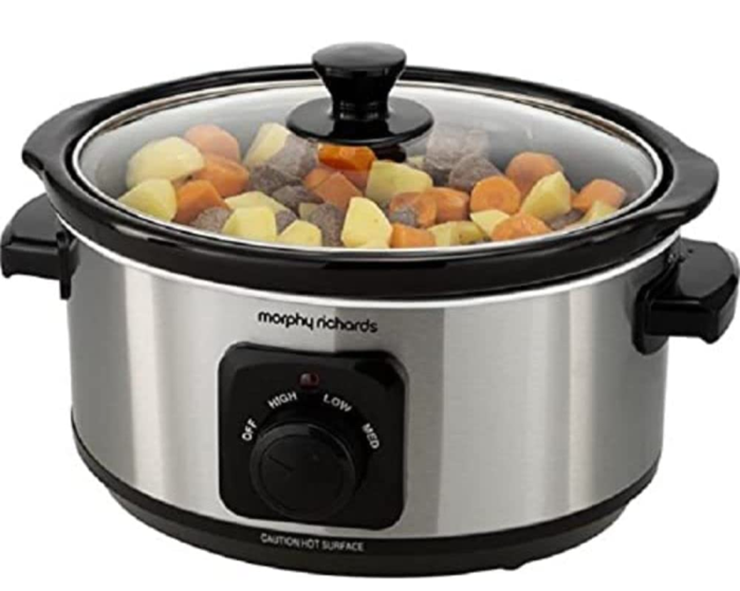FabulousFusionFood's Crockpot/Slow Cooker Recipes Home Page
 Traditional electric slow cooker with a crock sleeve.
Traditional electric slow cooker with a crock sleeve.
Welcome to FabulousFusionFood's Crockpot/Slow Cooker Recipes Page — A slow cooker, also known as a crock-pot (after a trademark owned by Sunbeam Products but sometimes used generically in the English-speaking world), is a countertop electrical cooking appliance used to simmer at a lower temperature than other cooking methods, such as baking, boiling, and frying. This facilitates unattended cooking for many hours of dishes that would otherwise be boiled: pot roast, soups, stews and other dishes (including beverages, desserts and dips).
Slow cookers achieved popularity in the US during the 1940s, when many women began to work outside the home. They could start dinner cooking in the morning before going to work and finish preparing the meal in the evening when they came home.
The Naxon Utilities Corporation of Chicago, under the leadership of electrical engineer Irving Naxon (born Irving Nachumsohn), developed the Naxon Beanery All-Purpose Cooker for the purposes of cooking a bean meal. Naxon was inspired by a story from his mother which told how back in her native Lithuanian town, his grandmother made a traditional Jewish stew called cholent which took several hours to cook in an oven. A 1950 advertisement shows a slow cooker called the "Simmer Crock" made by the Industrial Radiant Heat Corp. of Gladstone, New Jersey.
Slow Cooker:
A basic slow cooker consists of a lidded round or oval cooking pot made of glazed ceramic or porcelain, surrounded by a housing, usually metal, containing an electric heating element. The lid itself is often made of glass, and seated in a groove in the pot edge; condensed vapour collects in the groove and provides a low-pressure seal to the atmosphere. The contents of a crock pot are effectively at atmospheric pressure, despite the water vapor generated inside the pot. A slow cooker is quite different from a pressure cooker and presents no danger of an abrupt pressure release.The 'crock', or ceramic pot, itself acts as both a cooking container and a heat reservoir. Slow cookers come in capacities from 500ml to 7l. Because the heating elements are generally located at the bottom and often also partway up the sides, most slow cookers have a minimum recommended liquid level to avoid uncontrolled heating. Some newer models have coated aluminium or steel 'crocks' which, while not as efficient as ceramic at retaining heat, do allow for quicker heating and cooling as well as the ability to use the 'crock' on the stove top to brown meat prior to cooking.
Many slow cookers have two or more heat settings (e.g., low, medium, high, and sometimes a 'keep warm; setting); some have continuously variable power. In the past, most slow cookers had no temperature control and deliver a constant heat to the contents. The temperature of the contents rises until it reaches boiling point, at which point the energy goes into gently boiling the liquid closest to the hot surface. At a lower setting, it may just simmer at a temperature below the boiling point. While many basic slow cookers still operate in this manner, newer models have computerized controls for precise temperature control, delayed cooking starts and control via a computer or mobile device.
To use a slow cooker, the cook places raw food and a liquid, such as stock, water, or wine, in the slow cooker. Some recipes call for pre-heated liquid. The cook puts the lid on the slow cooker and turns it on. Some cookers automatically switch from cooking to warming (maintaining the temperature at 71–74°C after a fixed time or after the internal temperature of the food, as determined by a probe, reaches a specified value.
Cheaper cuts of meat with connective tissue and lean muscle fibres are suitable for stewing, and produce tastier stews than those using expensive cuts, as long slow cooking softens connective tissue without toughening the muscle. Slow cooking leaves gelatinized tissue in the meat, so that it may be advantageous to start with a richer liquid. The low temperature of slow-cooking makes it almost impossible to burn even food that has been cooked too long. However, some meats and most vegetables become nearly tasteless or 'raggy' if over-cooked.
Food can be set to slow-cook before leaving for the day so it is ready on return. Many homeowners with rooftop solar panels switch to slow cooking because it draws under 1 kW of power and can therefore be powered entirely by 1–2 kW panels during the day.[8] Some models include timers or thermostats that bring food to a given temperature and then lower it. With a timer-less cooker it is possible to use an external timer to stop cooking after a set time, or both to start and stop.
Despite their utility, it should be noted that slow cookers should not be used to cook dried kidney beans and other legume seeds.[10] These foods contain the highly toxic lectin phytohemagglutinin, making as few as four raw beans toxic.[12] This lectin is only deactivated by long soaking, then boiling in fresh water at 100°C for at least thirty minutes.
Modern multi-cookers typically have a slow cooker setting as well as pressure cooker and sauté settings meaning that they can brown onions, cook foods like beans safely and quickly and then finish a dish by slow cooking all day, saving energy.
The alphabetical list of all the crockpot/slow cooker recipes on this site follows, (limited to 100 recipes per page). There are 47 recipes in total:
Page 1 of 1
Page 1 of 1